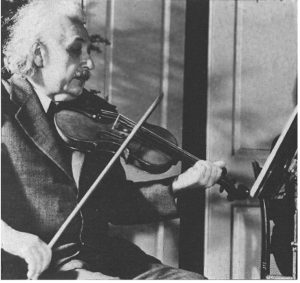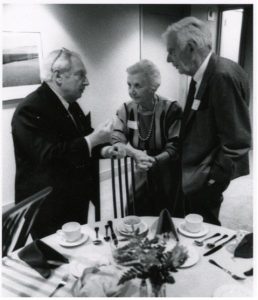Written by Dick Crane, 1993
When I was a boy in Turlock, California (around 1920) I started taking violin lessons from a Hungarian named Anton Ruby. He was the organist at the local movie theater. In those days the silent movies were accompanied by piano or organ music. The player was a special breed. Their heads contained music for every mood on the screen. He played through the whole performance and had to change the music to suit what was on the screen: fist fight, love scene or whatever. They watched the screen and could change the music instantly.
Ruby taught music, seemingly any instrument. I practiced a lot and played in the orchestras all through high school and college. After I had progressed some, he offered to get me a better violin. As I remember, my parents paid $200. (many times that in today’s dollars) for him get me a good one from “the old countryâ€. He said the one he got was not new – it had been played for many years, which made it better. He also ordered a case from a Chicago wholesale place, one covered with alligator hide. (There were no animal rights activists in those days, so I got away with carrying my alligator hide case.) Then he gave me lessons. Man of all talents! I bought the two good Pernambuco wood bows later, on different occasions, from a music company in San Francisco. I played the violin in the school orchestras, through both high school and undergraduate college, but I quit when I started graduate work, and never returned to it, which I now regret.
I took violin lessons and played around with the violin for quite a long part of my life – seriously. But then also, I bought a cheap violin once or twice and opened-it-up and tried to do various things – just experimenting with it, to see what would happen when I put different things inside it, and then played it.
I even hauled my violin in its alligator case all around Europe after graduating from Cal-Tech with my B.S., when I was looking at the possibility of doing graduate work at a European University. I kick myself now, as I never even opened the case, but hauled it everywhere.

While I was a graduate student at Cal-Tech, Dr. and Mrs. Einstein lived in the Faculty Club just two doors down from my room. Albert was an accomplished violin player, though he would never play before an audience. In the evenings, I could often hear violin music resonating down the halls. I wish I had thought to tape-record Einstein playing his fiddle. It certainly would have been interesting to play my violin along with him.
Many years later, about 1955, (without saying who’s to blame) the violin got dropped from our upper floor down onto the brick floor below. It was a wreck. I put it away and didn’t do anything about it until around 1990. I then took the wreckage to a local music company for repair. They told me it was not worth what the repair would cost. How could they know it was not an ordinary cheap one? So, I set to work putting the pieces together with epoxy cement. For a couple of things, I couldn’t do I took it to a violinmaker locally. Those jobs were setting the sounding post and re-fitting the four pegs. I knew at the time that I had not got the neck and fingerboard glued on exactly straight, but good enough for playing. I took it to a violinist friend who played it and pronounced it excellent. I understand the neck and fingerboard have since been re-set, professionally.

The photograph is of Florence and me, talking with the noted violinist Isaac Stern, at a supper after his concert in Ann Arbor in 1990. I had a question for him. Why is it that you look at 50 violinists in a symphony orchestra, and see not one of them is playing left-handed, while one person out of 5 in the population is left-handed? Are left-wingers not hired in symphonies? Isaac Stern’s answer was there are many left-handers in the violin section, but they learn the violin right-handed. He said it is not harder to learn one way than the other if you start that way. Left-handed instruments are rarely made.
I gave my good old violin to Beth, my granddaughter. She was riding to school with it on the back of her bicycle until they had it appraised! She doesn’t ride to school with it on her bike anymore! The worst thing is it has a case that’s covered with alligator skin. And, if you walked down the street with it, some animal‑lover would get after you these days.
